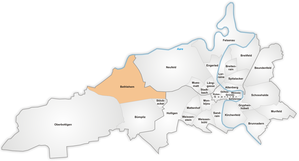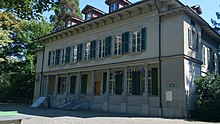Bern-Bethlehem
|
Bethlehem Statistical District of Bern |
|
|---|---|
| Coordinates | 595 535 / 200157 |
| height | 480- 632 m |
| surface | 4.2441 km² |
| Residents | 14,341 (2019) |
| Population density | 3379 inhabitants / km² |
| Proportion of foreigners | 39.8% (2019) |
| Unemployment rate | 3.9% (20) |
| BFS no. | 351032 |
| Post Code | 3018, 3020, 3027, 3032 |
| district | Bümpliz-Oberbottigen |
Bethlehem is a statistical district in the west of Bern . It belongs to district VI, Bümpliz-Oberbottigen .
Bethlehem includes the quarters Riedern , Eymatt , Eichholz , Bethlehemacker , Old Bethlehem , Untermatt , Blumenfeld , Ackerli , Tscharnergut , Brünnen , Gäbelbach and Holenacker , which are common in people's daily dealings with one another .
The resident population in 2019 was 14,341, of which 8,638 were Swiss and 5,703 were foreigners.
history
Bethlehem was a smaller hamlet on what is now the territory of Blumenfeld and Old Bethlehem . Until the end of the 19th century, the area was dominated by agriculture. As the old municipality of Bümpliz , it was located in the border area between Burgundy in the west and the Alemanni in the east. There are four theories for the origin of the name (documented in writing since 1508): (1) The nearby monastery of the Teutonic Order had built a processional path. In addition to Bethlehem, the names "Jerusalem" and "Jordanbach" in the Bremgarten Forest, which can still be found on old maps, are a reminder of the stations on this path . Bethlehem was then transferred to the developing village in the Bümpliz municipality. (2) From 1688, however, there is also a description as "Beth el hem", which means that the name could be derived from the names Berchtold ("Berthel") or Bado ("Badilo", "Betilin"). -hem then means home. (3) Unproductive arable land was formerly known as "Bethlehemsacker". (4) Ultimately, it is possible that Bethlehem was originally called "Bettelheim" because of the poor settlers. In the last two cases mentioned, an adjustment to the name of the biblical place would have taken place later.
In 1918 the Bümplizer approved the incorporation agreement with Bern with 631 yes to 17 no; economic reasons were decisive for this.
Due to the housing shortage during and after the Second World War, housing construction was intensified. A “patchwork-like arrangement of independent settlements” emerged. The building boom in the 1960s and 1970s did not change this either. The large-scale developments were carried out in isolation from one another, they were only designed in a uniform manner. Bümpliz-Bethlehem became a suburb of Bern with a heterogeneous character without a clearly identifiable center. Basically everything was finished in the mid-eighties. There are hardly any opportunities to make major urban changes. Nevertheless, some densities of the settlement found and continue to exist. Since many buildings are listed, demolition and new construction is at least difficult.
Development
Most of the development consists of large apartment blocks (the first to be built in Switzerland ). The best-known high-rise estates are Tscharnergut , Gäbelbach , Bethlehemacker and Holenacker . As they were groundbreaking for the time, some of the buildings are now protected and are considered to be of historical interest. In addition, single and multi-family houses and terraced houses are predominant, most of which also date from the post-war period.
Bern-Bethlehem and Bümpliz have one of the most important architectural landscapes of the post-war period in Switzerland. When Bern had over 100,000 inhabitants for the first time after the Second World War, new living space urgently had to be created, and so building consortia and the city of Bern bought many of the large Bernburg country estates in what is now district VI, in order to initially build large single and multi-family houses such as z. B. the Bethlehemacker the Meienegg , later also large-scale residential developments such. B. the Tscharnergut or the Gäbelbach to build.
The only possible extension was later to the west, Bern-Brünnen was built in 2004 on an area previously used for agriculture.
Under the name Chantier Bethlehem West , a draft of a master plan was presented in November 2019 on how urban development should be planned in Bethlehem by 2030. Mainly through internal densification, 1,500 additional apartments for 3,000 residents, as well as commercial / service space and shopping space, are to be gained. 2000 new jobs are to be created.
The expansion of Bern (17,000 new residents are planned by 2030) is also to take place in the west, in which, in addition to densification (for Bethlehem), further apartments are to be built "on the greenfield", Niederbottigen seems intended for this .
population
In 2007, Bethlehem had the highest of all suburbs in the city of Bern, with 34.9% foreigners and 12,527 registered residents. The districts “ yellow quarter” ( clock tower to Käfigturm ) and “ red quarter” (Käfigturm to Hirschengraben ) of District I: Inner City , however, have an even higher proportion of foreigners with 36.3% and 38.8% respectively. With 15,671 registered inhabitants, only the neighboring Bümpliz has more inhabitants.
geography
Bethlehem is located in the west of the city of Bern . In the north, Bethlehem is delimited by the Great Bremgarten Forest, which is followed by the Eymatt . This is located south of the Wohlensee , which in turn Hinterkappelen follows. The Neufeld district is located east of Bethlehem , Stöckacker to the southeast , Bümpliz to the south and Oberbottigen to the southwest. In the west - but already directly south of the Gäbelbach district - is the focus of development in Brno, including the Westside shopping and adventure center, which opened in 2008. The Stadtbach partially flows through Bethlehem.
traffic
Bethlehem has good transport links. In addition to several main road connections, Bethlehem has its own A1 motorway access called Bern-Bethlehem. Bethlehem itself is served by the Bernmobil tram line 8 and the post bus line 101. In addition, on Thursdays, Fridays, Saturdays and Sundays, several moonliner lines run to Bethlehem and beyond in the early morning hours .
With the construction of the Brünnen (Westside) settlement, the area around the Gäbelbach has also had its own S-Bahn station since 2009. In addition, Bümpliz Nord station in the south of Bethlehem is served by several S-Bahn lines.
Attractions
Single buildings
Landhaus «Fellerstock»
The "Fellerstock" is a country house, presumably built by Viktor von Erlach (1648–1730), in the middle of today's large Fellergut development. For a long time it remained in the possession of various Bernese patrician families. In 1855 the owner at the time, Marie Ninet, had the mansion and the surrounding area redesigned (adding a storey, new hipped roof, setting up the English garden and two avenues). In 1877 Karl Feller-Sahli (1842–1905) acquired the estate, which earned him the name “Fellerstock”, which is still in use today and which it was to remain in his family until 1968. This year it became the property of the city of Bern. They wanted to cancel the construction first and replace it with a modern school building, but had to renovate it under public pressure and with the help of a financial contribution from the last owner family and integrate the planned classrooms into the old building.
Reformed church and parish hall
The reformed church and the associated parish house were built in 1958–1960 by the architect Werner Küenzi (1921–1997) as part of the last stage of the Bethlehemacker I settlement in the style of post-war modernism .
Special post office
Every year in the (pre-) Christmas period, the post office in Bern-Bethlehem set up a special post office where letters could be postmarked on site with a special postmark. After the closure of the Christmas post office , the special post office was set up in the Tscharnergut district center for a week in December. At the end of 2019 this will also open for the last time; The stamp is still available via the Post's stamp service: In future, Christmas mail can be posted in the normal post office in Bern-Bethlehem, and letters sent to "3027 Bethlehem" can also be stamped.
literature
- Anne-Catherine Schröter, Raphael Sollberger, Dieter Schnell, Michael von Allmen: Settlements of the post-war period in Bümpliz-Bethlehem, ed .: Society for Swiss Art History. No. 1025.Bern 2018, ISBN 978-3-03797-350-9 .
- District inventory Bethlehem 1994, edited by Gottfried Derendinger and Hans-Peter Ryser, Ed .: Monument Preservation of the City of Bern, Bern 1995.
Web links
Individual evidence
- ↑ Statistical districts and common quarters of the city of Bern on map.bern.ch Under "Topics" you can select individual layers
- ↑ Statistical districts and common quarters of the city of Bern on map.bern.ch Under "Topics" you can select individual layers
- ↑ Resident population 2019 report p. 4 on bern.ch
- ^ Walter Heim: Finding a hostel in Bethlehem . In: Swiss Archives for Folklore . Issue 1–2, 1974, pp. 31 ff . ( e-periodica.ch [accessed on February 9, 2016]).
- ↑ Bern-Bethlehem on tscharni.ch
- ^ Drita Hasani, Mark Meeder, Michael Moser: Settlement development in Bümpliz-Bethlehem: Urban development in Bern's district VI from 1890 to 2012 and their interaction with the infrastructure. Project work from 2012 on ika.ethz.ch
- ↑ The story of Bümpliz-Bethlehem From the “cultivation battle” to the oil crisis on siedlungen-buempliz.ch
- ↑ a b Search function of the city of Bern for protected buildings - enter "ARGE Bethlehemacker" under "Search for architect:"
- ^ Anne-Catherine Schröter, Raphael Sollberger, Dieter Schnell, Michael von Allmen: Settlements of the post-war period in Bümpliz-Bethlehem . Ed .: Society for Swiss Art History. No. 1025 . Bern 2018, ISBN 978-3-03797-350-9 .
- ↑ Chantier Bethlehem West Draft Masterplan QBB Forum from November 11, 2019 in Altens Schloss Bümpliz
- ↑ STEK 2016 urban development concept on bern.ch p. 44 f.
- ^ Adrian Müller: The expansion in the west of the federal government from 23 August 2016
- ↑ Statistical yearbook of the city of Bern - reporting year 2007 (PDF; 2.2 MB) p. 31.
- ↑ above: The Fellerstock. In: Quartierzeitung virtual Bern Bümpliz Bethlehem. Retrieved September 10, 2019 .





